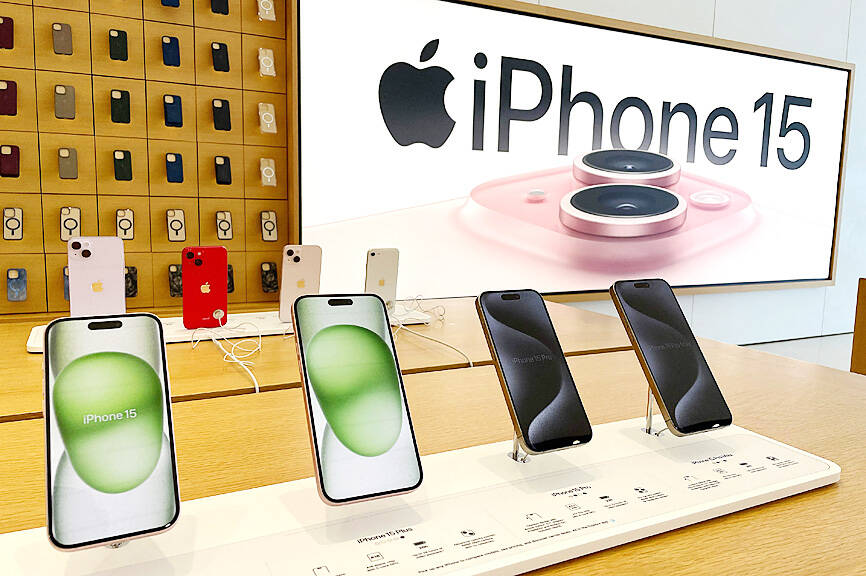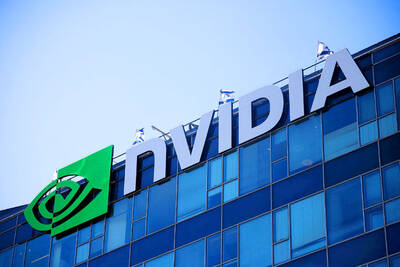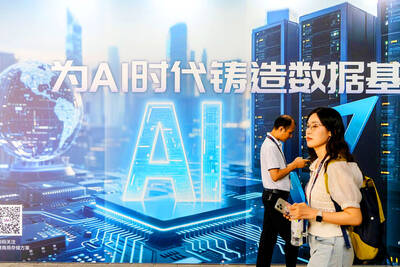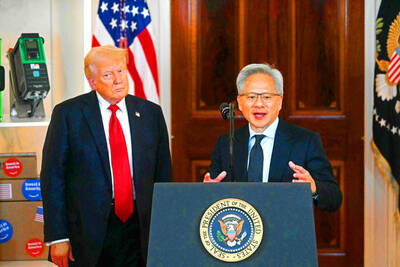Apple Inc’s disappointing holiday-quarter outlook has cast a spotlight on its mounting problems in China, where the iPhone maker is struggling with the unexpected rise of Huawei Technologies Co (華為) and an increasingly hostile business environment.
Apple, which is trying to reverse several successive quarters of revenue decline, on Thursday reported its lowest revenue from the Greater China region since the middle of last year.
Revenue fell to US$89.5 billion in the fiscal fourth quarter, which ended on Sept. 30. That compared to an average Wall Street estimate of US$89.4 billion. Apple’s shares slid more than 3 percent after that number missed the average of five analysts’ projections by 11 percent.

Photo: AFP
Apple CEO Tim Cook assured Wall Street that iPhone demand remains strong in China, blaming Mac and iPad weakness instead.
However, he also predicted flat December-quarter revenue, dampening analysts’ expectations of a growth rebound.
“The challenges that Apple faces in China are unprecedented,” International Data Corp analyst Will Wong said. “It not only needs to deal with the political tensions and Huawei’s competition, but also a different consumer sentiment that is more rational and cautious in spending.”
Apple’s revenue in Greater China declined 2 percent — a steeper drop than the companywide figure. There are signs that the trend might persist: Initial sales of the iPhone 15 in China were 6 percent lower than its predecessor in part because of incursions by Huawei, the consultancy GfK said.
Aside from stronger competition, Apple faces growing risk from political tensions between Washington and Beijing.
Beijing has expanded a ban on Apple products to state-backed firms and government-backed agencies. Hon Hai Precision Industry Co (鴻海精密) — which assembles the majority of Apple’s iPhones from its Chinese factories — is now under investigation over taxes and land use.
Shares of Hon Hai, also known as Foxconn Technology Group (富士康科技集團), and fellow iPhone assembler Pegatron Corp (和碩) fell 1.24 percent and 0.65 percent respectively yesterday.
Still, the iPhone continues to make inroads in the world’s biggest smartphone market, Cook said.
Various models accounted for the four top-selling phones in urban China, he said.
“China is an incredibly important market,” he said during a post-earnings conference call with analysts. “And I’m very optimistic about it.”
He did not face any direct questions about the situation.
If the overall Chinese smartphone market is contracting — as analysts have said — Apple’s results suggest that it is winning market share, Cook said.
He also touted that the company is opening a new store in the country this week. It is coming to Wenzhou in eastern Zhejiang Province and will be the company’s 46th in the region.

Taiwan Semiconductor Manufacturing Co (TSMC, 台積電) last week recorded an increase in the number of shareholders to the highest in almost eight months, despite its share price falling 3.38 percent from the previous week, Taiwan Stock Exchange data released on Saturday showed. As of Friday, TSMC had 1.88 million shareholders, the most since the week of April 25 and an increase of 31,870 from the previous week, the data showed. The number of shareholders jumped despite a drop of NT$50 (US$1.59), or 3.38 percent, in TSMC’s share price from a week earlier to NT$1,430, as investors took profits from their earlier gains

AI TALENT: No financial details were released about the deal, in which top Groq executives, including its CEO, would join Nvidia to help advance the technology Nvidia Corp has agreed to a licensing deal with artificial intelligence (AI) start-up Groq, furthering its investments in companies connected to the AI boom and gaining the right to add a new type of technology to its products. The world’s largest publicly traded company has paid for the right to use Groq’s technology and is to integrate its chip design into future products. Some of the start-up’s executives are leaving to join Nvidia to help with that effort, the companies said. Groq would continue as an independent company with a new chief executive, it said on Wednesday in a post on its Web

CHINA RIVAL: The chips are positioned to compete with Nvidia’s Hopper and Blackwell products and would enable clusters connecting more than 100,000 chips Moore Threads Technology Co (摩爾線程) introduced a new generation of chips aimed at reducing artificial intelligence (AI) developers’ dependence on Nvidia Corp’s hardware, just weeks after pulling off one of the most successful Chinese initial public offerings (IPOs) in years. “These products will significantly enhance world-class computing speed and capabilities that all developers aspire to,” Moore Threads CEO Zhang Jianzhong (張建中), a former Nvidia executive, said on Saturday at a company event in Beijing. “We hope they can meet the needs of more developers in China so that you no longer need to wait for advanced foreign products.” Chinese chipmakers are in

POLICY REVERSAL: The decision to allow sales of Nvidia’s H200 chips to China came after years of tightening controls and has drawn objections among some Republicans US House Republicans are calling for arms-sale-style congressional oversight of artificial intelligence (AI) chip exports as US President Donald Trump’s administration moves to approve licenses for Nvidia Corp to ship its H200 processor to China. US Representative Brian Mast, the Republican chairman of the US House Committee on Foreign Affairs, which oversees export controls, on Friday introduced a bill dubbed the AI Overwatch Act that would require the US Congress to be notified of AI chips sales to adversaries. Any processors equal to or higher in capabilities than Nvidia’s H20 would be subject to oversight, the draft bill says. Lawmakers would have